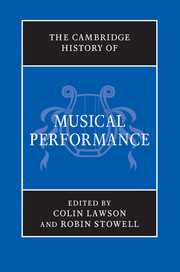Book contents
- Frontmatter
- PART I PERFORMANCE THROUGH HISTORY
- PART II PRE-RENAISSANCE PERFORMANCE
- 7 The Ancient World
- 8 Performance before c. 1430: an overview
- 9 Vocal performance before c. 1430
- 10 Instrumental performance before c. 1430
- 11 Case study: Guillaume de Machaut, ballade 34, ‘Quant Theseus / Ne quier veoir’
- PART III PERFORMANCE IN THE RENAISSANCE (C. 1430–1600)
- PART IV PERFORMANCE IN THE SEVENTEENTH CENTURY
- PART V PERFORMANCE IN THE ‘LONG EIGHTEENTH CENTURY’
- PART VI PERFORMANCE IN THE NINETEENTH CENTURY
- PART VII THE TWENTIETH CENTURY AND BEYOND
- PART VIII
- Index
8 - Performance before c. 1430: an overview
from PART II - PRE-RENAISSANCE PERFORMANCE
Published online by Cambridge University Press: 28 March 2012
- Frontmatter
- PART I PERFORMANCE THROUGH HISTORY
- PART II PRE-RENAISSANCE PERFORMANCE
- 7 The Ancient World
- 8 Performance before c. 1430: an overview
- 9 Vocal performance before c. 1430
- 10 Instrumental performance before c. 1430
- 11 Case study: Guillaume de Machaut, ballade 34, ‘Quant Theseus / Ne quier veoir’
- PART III PERFORMANCE IN THE RENAISSANCE (C. 1430–1600)
- PART IV PERFORMANCE IN THE SEVENTEENTH CENTURY
- PART V PERFORMANCE IN THE ‘LONG EIGHTEENTH CENTURY’
- PART VI PERFORMANCE IN THE NINETEENTH CENTURY
- PART VII THE TWENTIETH CENTURY AND BEYOND
- PART VIII
- Index
Summary
The first problem confronting anyone interested in medieval music performance is the sheer size of the Middle Ages. By far the longest period of Western European music history, it spans the fifth to the fifteenth centuries. It is difficult to generalise about a millennium of music-making. Major differences exist, for example, between a lament from Carolingian Gaul and a lute composition from fifteenth-century Italy. These two pieces differ dramatically in almost every respect, including their temporal, geographical, linguistic and social contexts. Another problem is the remoteness of the Middle Ages. From the Baroque period, for example, we have a wealth of performance treatises, printed music, musical instruments, and in some cases, letters and musical sketches from the hands of composers themselves. Very little to none of this sort of documentation survives for the medieval millennium. This is due not only to the fact that the majority of music was transmitted orally rather than through writing, but also because most of the music written down in the Middle Ages – on perishable surfaces such as wax tablets or parchment pieces – has not survived. To make matters worse, medieval music writers, trained as they were in the speculative tradition of Boethius, generally refrain from detailed performance descriptions or prescriptions. Nevertheless, some knowledge survives on medieval music performance, and research continues to improve current understanding of the many kinds of music made in the Middle Ages, on which the present chapter proposes a thumbnail sketch.
- Type
- Chapter
- Information
- The Cambridge History of Musical Performance , pp. 231 - 247Publisher: Cambridge University PressPrint publication year: 2012

